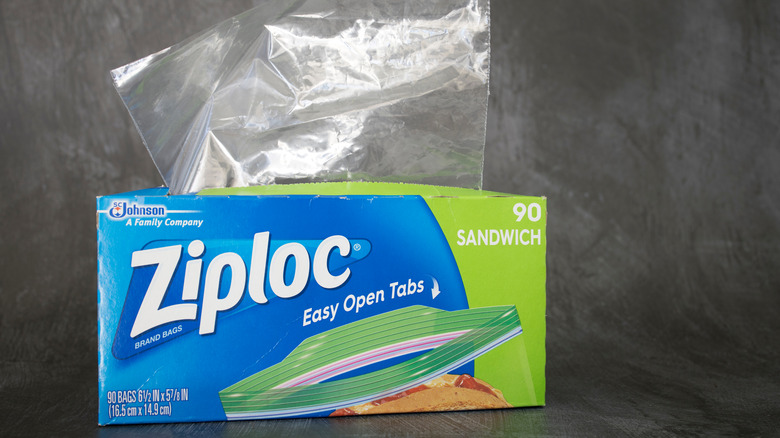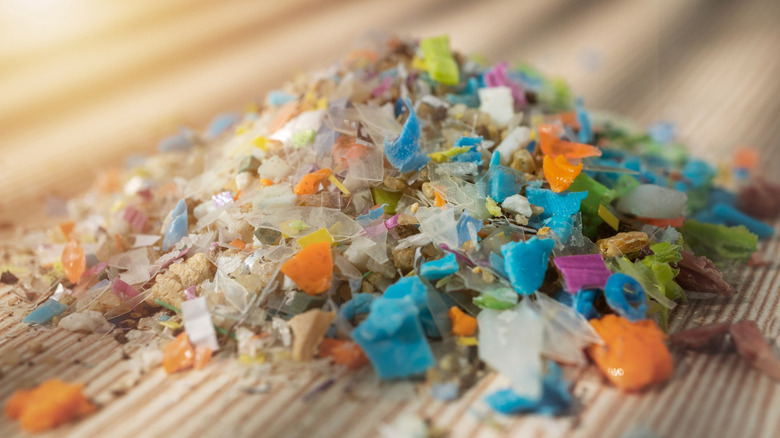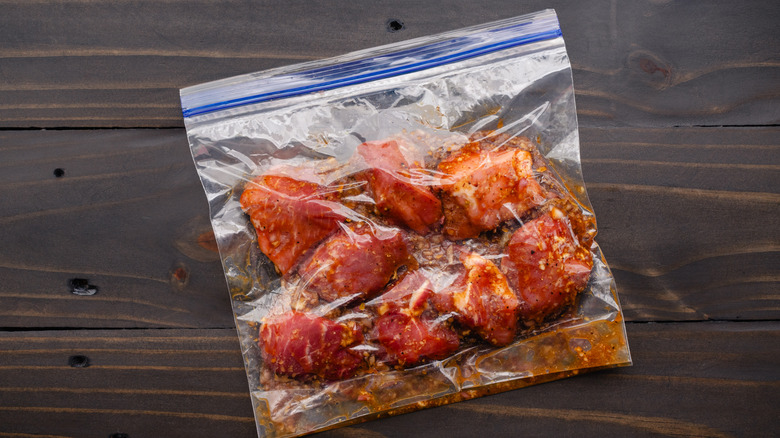Using Ziploc Bags Could Be Riskier Than You Think. Here's Why
Ziploc bags have been a staple of American kitchens for decades, but they're actually a relatively recent invention. The genesis of the now ubiquitous zipper bags dates back to Danish inventor Borge Madsen, who designed what he thought would be a new zipper system for clothes. Although that didn't work out, the invention eventually found its way into the now-ubiquitous bags and the Ziploc bag officially debuted in 1968.
Today, we all use Ziploc bags to store leftovers, keep food fresh, and marinate meats. The handy bags are even great for storing non-food items. But according to a 2025 class action lawsuit, using Ziploc bags in the freezer or microwave could pose a significant risk. The suit alleges S.C. Johnson & Son, Inc — the company that has owned Ziploc since 1998 — makes claims about their bags being "suitable" or "safe" for freezer and microwave use but that these claims are actually misleading. What's more, the complaint alleges that these claims put consumers at risk of exposure to microplastics — small plastic pieces less than 5 millimeters long which are produced when larger plastics break down.
Ziploc bags are made from low-density polyethylene and polypropylene plastic, which is generally more durable than those used in other plastic resealable baggies. However, according to the complaint these two plastics can break down under extreme temperatures associated with microwaves and freezers. The lawsuit references "scientific and medical evidence" when making this particular claim, so let's look at some science.
Polyethylene likely isn't as safe as you'd hope
A 2023 study published in Environmental Science and Technology investigated the release of microplastics from plastic containers. Researchers found that microwave heating caused the highest release of microplastics into food compared to other scenarios, and found that some containers would release as many as 4.22 million microplastic and 2.11 billion nanoplastic particles from just one square centimeter of plastic within three minutes of being in the microwave. Perhaps even more concerning, the team found that refrigeration and room-temperature storage for more than six months resulted in the release of millions to billions of microplastics and nanoplastics. The study didn't just look at plastic containers, either. In fact, researchers found that food pouches made with polyethylene — just like Ziploc bags — released more particles than polypropylene-based plastic containers.
When it comes to using Ziploc bags in a freezer, the belief is that freezing the plastic can make it more brittle, leading to more microplastic release. As Carmen Marsit, a professor of environmental health at Emory University's Rollins School of Public Health told Health, "The freezing process might make the plastic more brittle, so then you might have more shedding of those microplastics into the food products."
Ziploc's official website states that their bags can be used in the microwave, but "only to defrost or reheat food." The company also advises leaving the zipper open at least one inch to let steam and heat escape. There is, however, no mention of the bags being dangerous or leaching microplastics when used in the microwave, which according to the suit is a major oversight. An S.C. Johnson spokesperson responded to the claims in a statement to Health, stating, "We believe Ziploc products are safe when used as directed and that the lawsuit is without merit." Meanwhile, a piece in Plastics Today claims the researchers carried out an "extremely brief" chemical analysis of the particles which was inadequate to prove they were actually plastic (though the fact this article comes from a "community for plastics professionals" shouldn't be overlooked).
What's the problem with microplastics?
You might well have heard the term "microplastics," and even if you haven't looked into it, you probably have a vague sense that such a thing isn't good. But what exactly are microplastics and why are they so bad? Well, as the name might suggest, the term refers to very small pieces of plastic. Anything measuring less than 5 millimeters long is typically classified as microplastic, and while most such pieces are typically created when larger plastic breaks down, there are microplastics that are intentionally created. The little beads in hand sanitizer, for example, are technically microplastics. In fact, the cosmetic and self-care industry routinely adds microplastic beads to their products as exfoliating elements. Unfortunately, these small pieces ultimately end up being washed down the drain and the plastic trash finds its way out into the ocean and other marine habitats. These microplastics are then devoured by fish and other creatures, before finally finding their way back into our own bodies when we eat those very animals.
That's not the greatest outcome for us, as it turns out microplastics can carry contaminants including synthetic chemical compounds thought to cause cancer or birth defects. A 2023 study published in the Yonsei Medical Journal explains how experiments suggest that microplastics can have a major effect on humans, creating digestive and respiratory problems, and disrupting various systems including those concerned with immunity and reproduction.
What's more, chemicals in plastic food packaging, such as ortho-phthalates, PFAS, and perchlorate, can disrupt our endocrine system, which controls hormone creation and release. These chemicals can transfer from plastic into our food but they can also be consumed as microplastics, potentially causing problems with our hormonal system and disrupting everything from appetite and metabolism to cell growth regulation and neurodevelopment. Indeed, a 2024 study published in Environmental Science and Technology found that microplastics were "suspected" to adversely affect reproductive, digestive, and respiratory systems. Even more concerning, the researchers found a "suggested link" between microplastics and colon and lung cancer.
Are Ziploc bags really unsafe to microwave and freeze?
Research is ongoing as to how microplastics affect humans, so there's still plenty we don't understand. While studies have uncovered plenty of correlations between microplastics and health issues in humans, establishing a causal link between the two remains somewhat elusive. Even with that in mind, it's probably best to avoid potential extra exposure to microplastics.
The lawsuit against Ziploc itself is ongoing so it will be interesting to see how things turn out in that regard. At this stage, it remains undetermined whether microwaving or freezing Ziploc bags actually does produce microplastics. According to the company's statements in the wake of the lawsuit, their bags are safe, and some argue that the medical evidence alluded to in the complaint has issues of its own. But there are many people with knowledge of the topic that believe microwaving or freezing any plastic, Ziploc bags included, is a bad idea. As Brad Younggren of Circulate Health told CNET, "Repeated exposure to extreme temperatures — cold or hot — stresses plastic materials and can lead to the breakdown of their surface layers, releasing tiny plastic particles into food."
Either way, it's probably best to err on the side of caution. A 2019 study published in Environmental Science and Technology evaluated the number of microplastic particles in popular foods, taking into account those foods' recommended daily intake. Based on their findings, the researchers estimated that Americans consumed 39,000 to 52,000 particles annually, depending on age and sex, and between 74,000 and 121,000 when inhalation was taken into account. Water intake via plastic bottles was also thought to introduce a further 90,000 microplastics into the equation (though we could say goodbye to microplastics in water with one simple trick). The team also noted that while these estimates are subject to large amounts of variation, they were actually likely to be underestimates. In short, if you can avoid microwaving your Ziplocs, it's probably a good idea.



